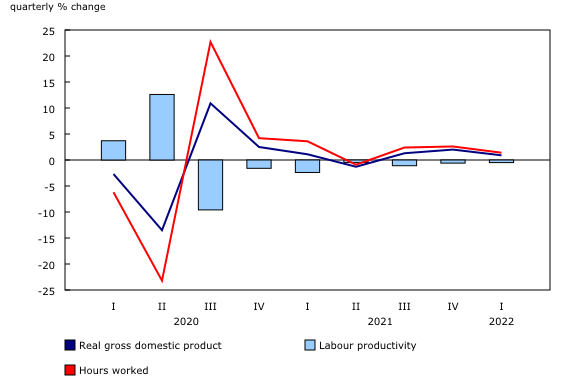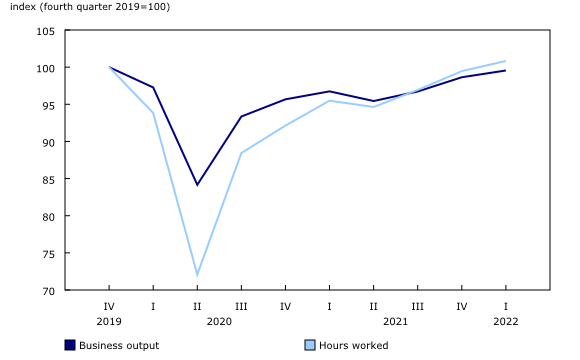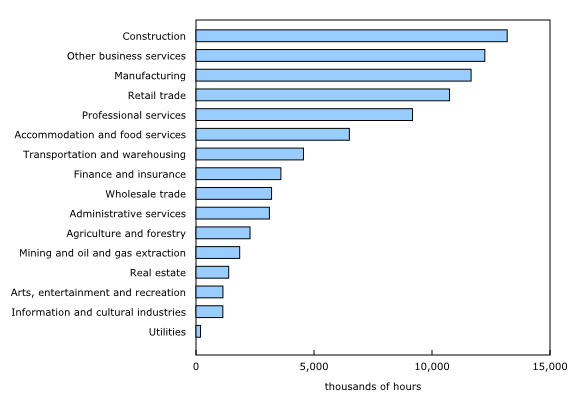Labour productivity, hourly compensation and unit labour cost, first quarter 2022
Released: 2022-06-03
First quarter 2022
-0.5% 
(quarterly change)
Productivity continues to decline
Labour productivity of Canadian businesses fell 0.5% in the first quarter, a decline similar to the previous quarter (-0.6%).
This was the seventh consecutive quarter decline in productivity, following a record increase in the second quarter of 2020, which was marked by the first lockdown measures in place from mid-March to early May 2020.
In the first quarter of 2022, productivity was 1.3% below its level in the fourth quarter of 2019, the last quarter before the start of the COVID-19 pandemic.
The first quarter of 2022 was marked by the tightening of public health measures in response to the Omicron variant of COVID-19 in most parts of the country in January, and then the easing of these measures in February and March. This affected both economic activity and the labour market throughout the quarter. Thus, business output growth slowed in the first quarter. At the same time, growth in hours worked also decelerated, but continued to outpace growth in business output, resulting in a decline in productivity in the first quarter.
Business output continues to grow, but at a slower pace than in the previous quarter
Real gross domestic product growth of businesses slowed to 0.9% in the first quarter, down from 2.0% in the previous quarter. With this gain, the output is much closer to its pre-pandemic level (-0.5% compared with the fourth quarter of 2019).
The slowdown in the first quarter was mainly due to the output of service-producing businesses, which rose 0.6% after increasing 2.3% in the fourth quarter of 2021. Output slowed in almost all service industry sectors, due to tightened restrictions on account of the Omicron variant of COVID-19 early in the quarter. In contrast, output continued to rise in goods-producing businesses, increasing 1.8% in the first quarter of 2022 after posting a 1.6% gain in the previous quarter.
The pace of growth in hours worked also slows
The increase in hours worked in the business sector, which reached 2.6% in the previous quarter, slowed to 1.4% in the first quarter. Despite this slowdown, hours worked exceeded their pre-pandemic level for the first time (+0.8% compared with the fourth quarter of 2019). This represents a slightly faster recovery than that of business output.
Hours worked rose at the same pace in both goods-producing businesses (+1.4%) and service-producing businesses (+1.4%) in the first quarter. Overall, all the main industry sectors saw an increase in hours worked, except for accommodation and food services (-1.6%).
For half of the major industry sectors, the recovery in hours worked is not yet complete compared with the fourth quarter of 2019, and the narrowing of gaps between sectors has continued. In total, 7 of the 16 industry sectors have surpassed their pre-pandemic levels, while the manufacturing sector has returned to its pre-pandemic level (+0.0%).
The increase in hours worked in the first quarter reflects a 0.2% increase in employment and a 1.2% gain in hours worked per job. The number of people with more than one job was up 1.3%, after increasing 5.8% in the fourth quarter of 2021. At the same time, the number of people who were absent without pay rose sharply (+11.2%), after falling 2.1% in the fourth quarter of 2021.
Impacts of the COVID-19 pandemic on hours worked in the business sector, first quarter of 2022
Estimates of hours worked in the business sector are mainly based on monthly data from the Labour Force Survey (LFS). It should be noted that for hours worked (used to measure productivity), both main and secondary jobs are considered—not only the main job as in the LFS. The main survey for the LFS for the reference period that includes the months of January, February and March does not capture losses of work hours outside the reference weeks. Just as in the previous eight quarters, to account for the hours lost because of the pandemic, the estimates were adjusted using a compilation of supplementary questions added to the LFS questionnaire in February, March and April 2022 for the respective reference months of January, February and March 2022. These adjustments are reflected in the data on hours worked and related measures (including labour productivity) for the first quarter of 2022.
Work hours lost due to the COVID-19 pandemic higher than the previous quarter
When considering only active workers or those on paid leave, the overall effect of the COVID-19 pandemic on hours worked in the business sector was a net loss of 86.0 million hours in the first quarter. This represents a higher loss than that registered in the fourth quarter of 2021 (-55.4 million hours).
At the industry level, the loss of work hours in the first quarter varied differently across the sectors.
The loss of work hours in the first quarter was mainly in construction, other business services, manufacturing, retail trade, professional services, and accommodation and food services. These sectors were the most affected by the restrictions put into place to contain the Omicron variant, just as they were earlier in the pandemic when public health measures were tightened in response to the other variants. Nearly 74% of all hours lost in the first quarter were in these six sectors, where a higher proportion of jobs require working in proximity to others.
In the first quarter, 13.2 million work hours were lost in the construction sector, the largest loss in any sector.
Service-producing businesses are primarily responsible for the decline in productivity
In the first quarter, the decline in productivity in the business sector was driven mainly by service-producing businesses, whose productivity fell 0.8%, after declining 0.6% in each of the previous two quarters. On the other hand, productivity in goods-producing businesses increased 0.4%, after remaining unchanged in the fourth quarter of 2021.
Overall, productivity was down in 9 of the 16 main industry sectors and was practically unchanged in other business services.
In the first quarter, mining and oil and gas extraction (-3.6%) and wholesale trade (-2.8%) posted sharp declines in their productivity. In contrast, the biggest increases in productivity were in agriculture and forestry (+3.4%), utilities (+2.6%), construction (+1.3%) and manufacturing (+1.2%).
In the United States, the labour productivity of businesses fell 2.0% in the first quarter, after rising sharply (+1.5%) in the fourth quarter of 2021. This is the biggest quarterly drop since the second quarter of 1960, when productivity decreased 2.1%. In the first quarter of 2022, real GDP of American businesses (-0.6%) fell for the first time since the second quarter of 2020, while hours worked (+1.4%) grew faster than in the fourth quarter of 2021 (+0.6%).
Growth in unit labour costs accelerates
Unit labour costs—that is, the cost of labour per unit of output—of Canadian businesses grew 2.7% in the first quarter, following zero growth in the previous quarter.
This accelerated pace of growth in unit labour costs reflects the sharp increase in average compensation per hour worked (+2.3%), while productivity declined 0.5%. In the fourth quarter of 2021, hourly compensation had declined 0.6%.
After remaining unchanged in the previous quarter, the average value of the Canadian dollar relative to the US dollar was down 0.5% in the first quarter. As a result of this depreciation, unit labour costs expressed in US dollars for Canadian businesses were up 2.2%, following no change in the previous quarter.
By comparison, unit labour costs of American businesses rose 2.8% in the first quarter, after edging up 0.3% in the previous quarter. This was the highest quarterly growth rate since the fourth quarter of 2020, when the rate was 3.3%.
Sustainable development goals
On January 1, 2016, the world officially began implementing the 2030 Agenda for Sustainable Development—the United Nations' transformative plan of action that addresses urgent global challenges over the following 15 years. The plan is based on 17 specific sustainable development goals.
The release "Labour productivity, hourly compensation and unit labour cost" is an example of how Statistics Canada supports the reporting on the global sustainable development goals. This release will be used to help measure the following goal:

Note to readers
Volatile data starting in the first quarter of 2020
Since the beginning of the health crisis due to COVID-19, quarter-to-quarter data have been particularly volatile, reflecting the impacts of the pandemic and health measures on economic activity and the labour market. Given the strong variations over the last nine quarters (including the first quarter of 2022), the percentage changes from the pre-pandemic level—i.e., from the fourth quarter of 2019—can better reflect the changes in productivity and related measures than percentage changes from quarter to quarter. However, the quarterly data in Table 1 of this release are presented only in the usual format: the percentage change from the same quarter in the previous year and the change from the previous quarter.
Revisions
With this release on labour productivity and related measures, data were revised back to the first quarter of 2021 at the aggregate and industry levels. These revisions are consistent with those incorporated in the release on quarterly gross domestic product (GDP) by income and expenditure and the release on monthly GDP by industry, released on May 31, 2022.
This release also incorporates the new 2021 benchmark data on provincial and territorial labour productivity and related measures, published on May 20, 2022.
Productivity measures
The term productivity in this release refers to labour productivity. For the purposes of this analysis, labour productivity and related variables cover the business sector only.
Labour productivity is a measure of real GDP per hour worked.
Unit labour cost is defined as the cost of workers' wages and benefits per unit of real GDP.
The approach to measuring real output in the business sector differs from the one that is used in the estimates by industry. For the business sector, output is measured using the expenditure-based GDP approach at market prices. This approach is similar to that used for the quarterly measures of productivity in the United States. However, output by industry is based on the value added at basic prices.
All the growth rates reported in this release are rounded to one decimal place. They are calculated with index numbers rounded to three decimal places, which are now available in data tables.
All necessary basic variables for productivity analyses (such as hours worked, employment, output and compensation) are seasonally adjusted. For information on seasonal adjustment, see Seasonally adjusted data – Frequently asked questions.
Next release
Labour productivity, hourly compensation and unit labour cost data for the second quarter of 2022 will be released on September 2.
Products
The Economic accounts statistics portal, accessible from the Subjects module of our website, features an up-to-date portrait of national and provincial economies and their structures.
The Latest Developments in the Canadian Economic Accounts (13-605-X) is available.
The User Guide: Canadian System of Macroeconomic Accounts (13-606-G) is available.
The Methodological Guide: Canadian System of Macroeconomic Accounts (13-607-X) is available.
Contact information
For more information, or to enquire about the concepts, methods or data quality of this release, contact us (toll-free 1-800-263-1136; 514-283-8300; infostats@statcan.gc.ca) or Media Relations (statcan.mediahotline-ligneinfomedias.statcan@statcan.gc.ca).
- Date modified:




